Choosing the right fabric for children's clothing isn't just about style—it's about safety, comfort, and peace of mind. More and more parents today are looking beyond price tags and paying closer attention to what touches their child's skin.
Why are organic cotton and bamboo perfect for kids' clothes?
Both fabrics are naturally hypoallergenic, breathable, and free from harsh chemicals. Compared to conventional materials, these options reduce allergy risks, offer all-day comfort, and contribute less environmental harm—making them ideal for children and conscious parents alike.
When it comes to children’s wear, fabric choice is no longer an afterthought—it’s the starting point.
Why are organic cotton and bamboo ideal for children’s sensitive skin?
Children’s skin is more porous and absorbent than adults’, which means it’s more vulnerable to irritation and chemical exposure. That’s where fabric truly matters.
What makes organic cotton and bamboo skin-friendly for kids?
Organic cotton is grown without harsh pesticides or synthetic chemicals, which makes it less likely to trigger allergies or rashes. Bamboo fabric, naturally hypoallergenic and antibacterial, helps prevent irritation—even for babies with eczema. In contrast, conventional fabrics often contain chemical residues that can harm delicate skin.

The Gentle Touch: How Organic Fabrics Protect Sensitive Skin
Unlike conventional cotton, which may be treated with fertilizers, bleach, or formaldehyde, organic cotton is grown and processed with minimal intervention. That means fewer irritants making contact with a child’s skin.
Bamboo rayon, processed from bamboo pulp, retains antibacterial properties that help reduce odor and skin infections. Its ultra-smooth fibers are gentle to the touch, often compared to silk or cashmere. This makes it especially beneficial for children with skin sensitivities or conditions like eczema.
Here’s a quick comparison:
| Fabric Type | Skin Benefits | Chemical Exposure |
|---|---|---|
| Organic Cotton | Hypoallergenic, breathable, soft | Very low |
| Bamboo Rayon | Antibacterial, moisture-wicking, temperature-regulating | Very low |
| Conventional Cotton | Prone to pesticide residue, less breathable | High |
By choosing organic fabrics, parents are not only protecting their child’s skin but also supporting farming methods that keep toxins out of the ecosystem. It’s a small change that adds up to a big impact.
How do organic cotton and bamboo enhance comfort for kids?
Comfort is key for growing, active children. It’s the difference between a cranky toddler tugging at their shirt and a happy one playing freely on the playground.
Are these fabrics really more comfortable for children?
Yes. Organic cotton and bamboo are incredibly soft, breathable, and moisture-wicking. They help regulate body temperature, keeping kids cool in the heat and cozy in cooler weather. Plus, they hold up well to washing—important when little clothes get dirty fast.
Designed for Real Life: Soft, Breathable, and Durable
Softness isn't just a luxury—it’s essential when dressing babies and toddlers who can’t always express their discomfort. Organic cotton offers a buttery feel that stays gentle even after many washes. Bamboo fabric, meanwhile, has a natural sheen and smoothness that feels great against the skin.
But softness doesn't mean fragile. Both materials are surprisingly tough. Organic cotton has strong fibers that hold up to regular machine washing. Bamboo is flexible yet resilient, bouncing back after stretches and tumbles.
Another bonus? These fabrics help manage sweat and body temperature—something especially helpful for toddlers always on the move.
Why are these fabrics better for the environment?
Eco-friendly clothing isn’t just a buzzword—it’s becoming a new standard for many parents concerned about the planet their children will grow up in.
What makes organic cotton and bamboo more sustainable?
Organic cotton uses up to 91% less water than conventional cotton and is grown without synthetic chemicals. Bamboo, on the other hand, is a fast-growing, renewable resource that requires no pesticides or fertilizers. Both fabrics are biodegradable and reduce landfill waste.
Greener Growing, Cleaner Wearing
Let’s talk about farming.
Conventional cotton farming relies heavily on pesticides and water. Organic cotton skips the chemicals and uses farming methods that preserve soil and water systems.
Bamboo is even more impressive—it can grow a meter a day, doesn’t need to be replanted after harvesting, and captures more carbon than most trees. Its yield per acre is far higher than that of cotton, making it a smart choice for sustainability.
And when a bamboo or organic cotton T-shirt reaches the end of its life? It breaks down naturally, unlike synthetic fabrics which can linger in landfills for decades.
| Fabric | Water Usage | Chemical Use | Biodegradable | Carbon Footprint |
|---|---|---|---|---|
| Organic Cotton | Low | None | Yes | Moderate |
| Bamboo | Very low | None | Yes | Very low |
| Synthetic (e.g. polyester) | Very low | High | No | High |
Are these fabrics safer for children’s health?
It’s not just about comfort or ethics. Fabric choices directly affect a child's long-term health.
Why is chemical-free clothing safer for kids?
Children’s bodies are still developing, making them more susceptible to chemical exposure. Organic cotton and bamboo are often certified by standards like GOTS, which ensure no harmful residues are left behind. Choosing these fabrics reduces the risk of exposure to substances linked to hormonal disruption or skin issues.
Certified Safe: What Parents Should Know
Organic and bamboo fabrics often carry certifications like:
- GOTS (Global Organic Textile Standard) – ensures the entire production process is chemical-free.
- OEKO-TEX Standard 100 – tests for over 100 harmful substances in textiles.
These certifications give peace of mind. Clothes with no flame retardants, azo dyes, or formaldehyde are less likely to trigger allergies or respiratory issues.
Health-conscious parents are now checking tags not just for size—but for certification labels that tell the full story.
What do current trends say about consumer demand?
There’s a growing shift in the market—parents today are voting with their wallets.
Why are more parents choosing organic and bamboo kidswear?
Because it aligns with their values. Shoppers want clothes that are safe, comfortable, and kind to the planet. Many brands now offer organic lines in response. Though prices may be slightly higher upfront, the value comes through in durability, health benefits, and peace of mind.
The Conscious Parent’s Choice
From local boutiques to global brands, more collections are featuring eco-fabrics. Parents are reading labels, asking questions, and choosing clothing that reflects their values—safety, sustainability, and ethics.
And the shift isn’t slowing down. In fact, it’s picking up pace.
| Trend | Impact on Market |
|---|---|
| Conscious consumerism | Growing demand for organic materials |
| Health awareness | Parents prioritizing chemical-free wear |
| Eco-awareness | Brands adopting sustainable practices |
Conclusion
Organic cotton and bamboo aren’t just better fabrics—they’re better choices. For the planet. For parents. And most importantly, for kids.



